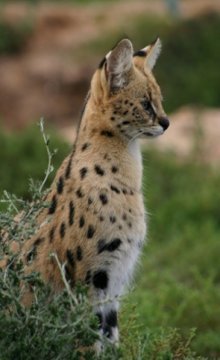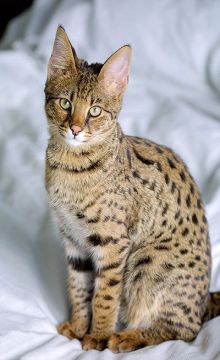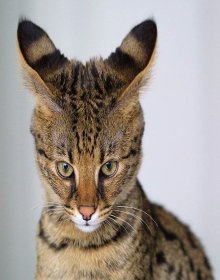Savannah Cat Info - all you want to know about the Savannah cat breed
Savannah Cat Info - The origin of the breed

In April 1986 Judee Frank, a Bengal breeder, crossbred a male Serval (a Serval is pictured on the right) with a Siamese cat. The Serval belonged to Suzi Woods. The result was the first Savannah cat, aptly named Savannah.
Patrick Kelley purchased one of Savannah’s kittens in 1989 and he was instrumental in establishing a new domestic cat breed based on Judee Frank and Suzi Woods’s cross. Patrick Kelley enlisted the help of Serval breeder Joyce Sroufe in getting the breed recognized.
In 1996, Patrick Kelley and Joyce Sroufe wrote the original version of the Savannah cat breed standard, which they presented to the board of TICA (The International Cat Association.) In 2001 the breed was accepted for registration and the Savannah is now shown at TICA shows in the Advanced New Breed Class.
Savannah Cat Info - The classification of the breed
Each generation of Savannahs is marked with a filial number - this is due to Savannahs being a crossbreed between servals and domestic cats. Cats produced directly from a mating between a Serval and a domestic cat are the F1 generation, and is considered to be 50% serval if a domestic queen is used in the breeding.
An F1 generation Savannah is very difficult to produce because of the difference in the gestation periods of the Serval (75 days gestation) and a domestic cat (65 days gestation.) Often a pregnancy will be aborted or the kittens will be born prematurely. Because Servals are so picky when it comes to choosing a mate, they will often not breed with a domestic cat.
An F2 generation Savannah is a cat that has a Serval grandparent and is the offspring of the F1 generation female, and an F3 generation Savannah is a cat that has a Serval great-grandparent. The earlier the generation, the more expensive the cat will be. TICA uses SV as a code for the Savannah breed, and if a Savannah is crossed with another Savannah, it will be referred to by breeders as SVxSV, and this code will be used in addition to the filial number.
Savannah Cat Info - The look of the breed

The Savannah cat breed is considered a medium to large cat breed. Because of the Savannah’s long legs and slim build, they tend to appear bigger than they actually are. F1 and F2 hybrid Savannah males are usually the largest, due to the genetic influence of the Serval. Savannahs from an early generation can weigh between 20 to 30 pounds with later generations Savannahs weighing between 12 to 20 pounds. An 18 month old Savannah cat called Scarlett’s Magic holds the Guinness Book world record as the tallest domestic cat at 17.1 inches from shoulder to toe. Scarlett’s Magic is owned by Kimberly and Lee Draper of Bella Gattini Cattery.
The domestic breed of cat that is used will influence the look of the Savannah cat. TICA only allows domestic out-crosses with the Ocicat, the Oriental short-hair, the Egyptian Mau and the Domestic short-hair. Some Savannahs are often described as having a “wild look” and this is due to the presence of distinguishing Serval characteristics. These characteristics include the various color markings and the tall ears.

The body and the legs of the Savannah are long and they have a long, slender neck. They have tall ears that stand erect, and the ears have ocelli, which is a central light band bordered by dark grey, dark brown or black. This gives their ears the appearance of having an “eye.” The tail is normally short with a solid black tip. The Savannahs eyes are hooded and have “cheetah tear” markings running from the corner of the eyes down to the sides of the nose and whiskers.
Early generations of the Savannah cat breed have dark spotting on a lighter coat and to preserve this look, breeders use Bengals and Egyptian Mau breeds for the crossing. The TICA breed standard allows only silver spotted tabby, brown spotted tabby, black and black smoke. The coat will be greatly influenced by the breed of domestic cat used for the cross-breeding.
Savannah Cat Info - The temperament of the breed
Savannah cats are an extremely loyal and people-orientated cat breed. They enjoy games of fetch (much like a dog) and are easy to train to walk on a leash. If the Savannah is properly socialized, they will quickly take to new people and other pets. Some Savannahs have been known to head-butt people or even pounce on people as a greeting.
Savannahs are very intelligent, curious and love to jump. A Savannah can jump up to 7 feet high from a standing position, and you will probably find the cat on top of cupboards, doors and refrigerators. This cat breed is not afraid of water at all. The Savannah will play or immerse themselves in water.
Savannahs like to “talk” to their owners or other pets with a mixture of chirping and meowing sounds. Don’t expect the Savannah to be a lap cat or a cat that can sit still for long periods of time. They need regular interaction and exercise, and games that involve running and jumping are much appreciated.
Savannah Cat Info - Health considerations of the breed
No known breed-specific health issues exist and the Savannah has what is called “hybrid vigor.”
Servals generally have smaller livers relative to their body size and some Savannahs have the same genetic trait. Care must therefore be taken when a veterinarian has to prescribe certain medicines, as the liver might not be able to metabolize the medication as needed. For this reason, Ketamine is not used as an anesthetic by veterinarians.
Savannah Cat Info - Special considerations of the breed
It is best to speak to a specialist Savannah breeder or an exotic animal veterinarian where diet and special needs are concerned. The breeder will be able to advise you with regards to diet and supplements.







